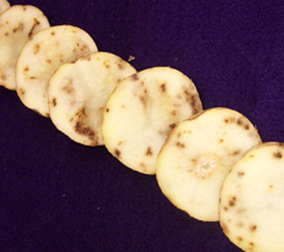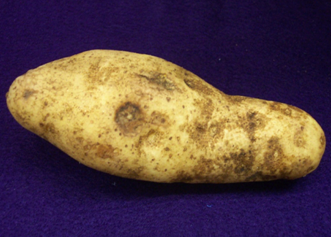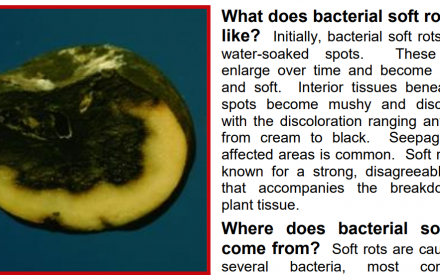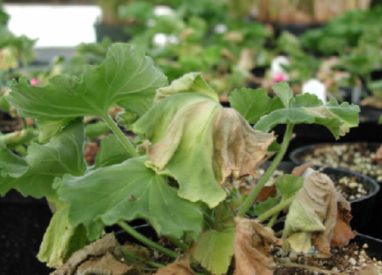What is corky ringspot?

Corky ringspot (also known as spraing) is a potentially serious viral disease of potato that has recently been detected in Wisconsin. The disease can cause severe losses due to the fact that it reduces potato tuber quality, making tubers unsuitable for use in potato chip production and undesirable to consumers as table stock. Variants of this disease (usually referred to as tobacco rattle) affect a variety of other plants including vegetable crops (e.g., beans, beets, peppers, and spinach), many herbaceous ornamentals (e.g., astilbe, bleeding heart, coral bells, daffodil, epimedium, gladiolus, hyacinth, marigold, tulip, and vinca) and many weed species (e.g., chickweed, cocklebur, henbit, nightshade, pigweed, purslane, prickly lettuce, shepherd’s-purse and sowthistle).
What does corky ringspot look like?
Symptoms of corky ringspot vary depending on the variety/cultivar of potato affected, and depending on environmental conditions. Foliar symptoms are rare, but on occasion can include reduced leaf size, puckering and mottling (i.e., blotchy light and dark coloring). More commonly, corky ringspot manifests itself underground as corky arcs, rings or flecks that form on or within tubers. Thinner-skinned and lighter-colored potato varieties are more likely to exhibit obvious ring symptoms on the surfaces of tubers. Symptoms similar to those caused by corky ringspot can be caused by other potato viruses such as alfalfa mosaic virus, potato mop-top virus, and certain strains of potato virus Y.
Where does corky ringspot come from?
Corky ringspot is caused by the Tobacco rattle virus (TRV) which is spread primarily by stubby-root nematodes, a group of microscopic, worm-like organisms in the genera Trichodorus and Paratrichdorus. These nematodes feed on the roots of infected plants (vegetables, ornamentals or weeds), acquiring TRV, then move to non-infected plants where their subsequent feeding spreads the virus. TRV also can be spread mechanically when knives or other tools that are used to cut tubers for seed pieces, or that are used to divide ornamental plants, become contaminated. In addition, on ornamentals, TRV can be spread by pruning and grafting, and via movement of seed from infected plants.
How do I save potatoes with corky ringspot?
Once potatoes have become infected with TRV, they remain infected indefinitely. Infected plants cannot be treated in any way to eliminate the virus and should be removed and disposed of by burning (where allowed by local ordinance), burying or composting. Before destroying symptomatic plants, you may want to have them tested to verify the presence of TRV. Note that ELISA (a technique commonly used to test for other potato viruses) is not a reliable test for TRV; polymerase chain reaction (PCR) should be used to test for this virus. Once TRV is introduced into a field, it is likely to remain there indefinitely. Stubby-root nematodes can carry the virus for extended periods and weed species can serve as reservoirs of the virus indefinitely.
How do I avoid problems with corky ringspot in the future?
The best way to prevent problems with corky ringspot is to avoid introducing TRV onto your property. Be sure to grow potatoes from seed that is certified as being free of TRV. Currently, seed potatoes produced in Wisconsin are considered TRV-free. Also avoid introducing the virus on infected ornamental plants. Carefully inspect ornamentals (see above for a partial list of susceptible species) prior to purchase for symptoms caused by TRV and DO NOT buy symptomatic plants. Alternatively (and preferably), avoid growing susceptible species altogether, and grow plants that are not susceptible to TRV. Non-susceptible plants include, but are not limited to, annual phlox, carnation, carrot, devil’s trumpet (downy thorn-apple), Scotch spearmint, sorrel, sweet William, zinnia and zombie cucumber.
To limit potential spread of TRV, routinely decontaminate tools (e.g., knifes or other cutting tools) that come into contact with potentially infected plant material (e.g., whole tubers that are cut into seed pieces, or ornamentals that are being divided). Also decontaminate tires, tools (e.g., spades or hoes) and any other object (e.g., shoes or boots) that might transport stubby-root nematode-infested (and thus TRV-infested) soil from field to field. First rinse any excess plant tissue or soil from these items, then treat them for at least 30 seconds in a solution that is a combination of 1% sodium lauryl sulfate and 1% Alconox (an industrial detergent). Trisodium phosphate (available at most local hardware stores) can also be used.
Also consider routinely testing soils for the presence of stubby root nematodes. Knowing the level of these nematodes in a field can provide information on the likelihood that TRV will spread should the virus be introduced.
Finally, DO NOT ever produce seed potatoes in fields with a history of corky ringspot or other TRV diseases. Also avoid using infested fields for potato or other vegetable production. If you decide to use a TRV-infested field for non-seed potato production, be sure to grow a TRV-resistant potato variety. The potato varieties ‘Castile’, ‘Millennium Russet’, ‘Red Pearl’, ‘Symfonia’, and ‘St. Johns’ have all been reported to have at least moderate levels of resistance to TRV.
For more information on corky ringspot:
Contact the University of Wisconsin Plant Disease Diagnostics Clinic (PDDC) at (608) 262-2863 or pddc@wisc.edu.
Authors: Brian Hudelson and Amy Charkowski, UW-Madison Plant Pathology
Last Revised: 02/29/2024
D-number: D0034
References to pesticide products in this publication are for your convenience and are not an endorsement or criticism of one product over similar products. You are responsible for using pesticides according to the manufacturer’s current label directions. Follow directions exactly to protect the environment and people from pesticide exposure. Failure to do so violates the law.
Thanks to Tom German, Amanda Gevens and Russell Groves for reviewing this document.
A complete inventory of UW Plant Disease Facts is available at the University of Wisconsin-Madison Plant Disease Diagnostics Clinic website: https://pddc.wisc.edu.
Send a Plant Sample for Analysis
Be cautious when self-diagnosing plant health issues. Very few diseases can accurately be diagnosed by eye.
Contact the UW Plant Disease Diagnostics Clinic (PDDC), and for a small fee, clinic staff can examine a plant, determine the cause of the disease/disorder, and provide advice on how to control or prevent the issue.
Download Article






 Tobacco Rattle
Tobacco Rattle Tomato Spotted Wilt of Potato
Tomato Spotted Wilt of Potato Bacterial Soft Rot
Bacterial Soft Rot Ralstonia Wilt
Ralstonia Wilt


